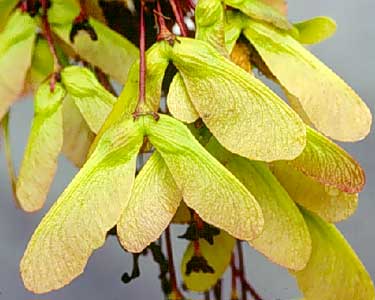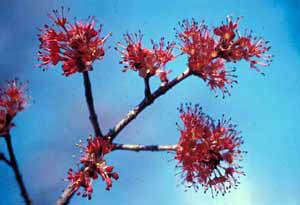Name That Tree
By Gil Medeiros
If you selected Red Maple (Acer rubrum), you are correct. Your prize this month is a bushel of Red Maple leaves. Please redeem your prize on or about November 15 at practically any curbside in Fairfax County. Bring your own basket.
Red Maple, also known as Swamp Maple, is one of the grand landscape trees of Northern Virginia because it is handsome and easy to grow. It grows to about 65 feet in height and 35 to 40 feet wide. In the large 35- to 40-foot diameter space under the Red Maple, this tree, with its deep shade and extensive system of surface roots, will ultimately defeat your best efforts to plant turfgrass. The tree will be happy and so will you when you finally decide to cover most of that area with mulch.

Red maple leaf
- Red Maples have toothed leaf margins. This is the botanists’ way of saying the leaves have jagged edges. This feature limits your choices to either Red Maple or Silver Maple.
- Red Maple leaves are relatively small. These leaves are 2 to 3 inches across usually while Silver Maple leaves are generally 4 to 5 inches across.
- Red Maple leaves often have only three lobes. Silver Maple leaves usually have five lobes with deep sinuses between them. Sinus is botanist lingo for a gap between two parts of a simple leaf. There is some variation from north to south in the number of lobes in a Red Maple leaf. To the south it is generally three; to the north it is often five.
- The mature size of a Red Maple is usually no more than 65 feet. Ash trees (if you still have one after the onslaught of the Emerald Ash Borer), Silver Maples and Eastern White Pines often tower over the Red Maples.
- Red Maple winged seed are known as samaras. Often the angle between the two seeds in a pair is narrower than shown in this photo.

Red Maple winged samaras
You may be surprised to learn that Red Maples can be tapped for sap like Sugar Maples. The sap is not of the same quality and quantity as that of Sugar Maples, but it is used commercially to make maple syrup and sugar. It is difficult to successfully tap Red Maples in Northern Virginia because the tapping season is short, and the tree begins to grow in early spring here.
Red Maples are moderately fast growing trees so they have softer wood than other maples that are prized for furniture making. Nevertheless, the wood of Red Maple is still useful for making furniture.

Red maple flower
There are various leaf spots and galls that appear on Red Maples. These are seldom of enough severity to affect the general health of the tree.
References
Red Maple, University of Kentucky Department of Horticulture
Verticillium wilt of trees and shrubs, University of Minnesota Extension
Red Maple, Virginia Tech Department of Forest Resources and Environmental Conservation